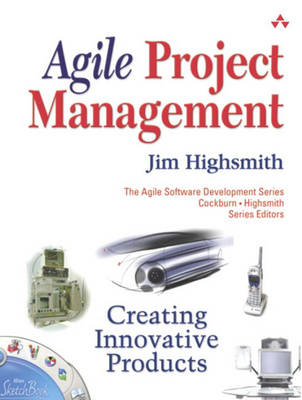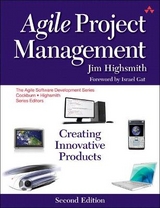
Agile Project Management
Addison-Wesley Educational Publishers Inc (Verlag)
978-0-321-21977-0 (ISBN)
- Titel erscheint in neuer Auflage
- Artikel merken
Please note - there is now a second edition of this book available, with the ISBN of 0321658396.
“Jim Highsmith is one of a few modern writers who are helping us understand the new nature of work in the knowledge economy.”
—Rob Austin, Assistant Professor, Harvard Business School
“This is the project management book we’ve all been waiting for—the book that effectively combines Agile methods and rigorous project management. Not only does this book help us make sense of project management in this current world of iterative, incremental Agile methods, but it’s an all-around good read!”
—Lynne Ellen, Sr. VP & CIO, DTE Energy
“Finally a book that reconciles the passion of the Agile Software movement with the needed disciplines of project management. Jim’s book has provided a service to all of us.”
—Neville R(oy) Singham, CEO, ThoughtWorks, Inc.
“The world of product development is becoming more dynamic and uncertain. Many managers cope by reinforcing processes, adding documentation, or further honing costs. This isn’t working. Highsmith brilliantly guides us into an alternative that fits the times.”
—Preston G. Smith, principal, New Product Dynamics/coauthor, Developing Products in Half the Time
One of the field’s leading experts brings together all the knowledge and resources you need to use APM in your next project. Jim Highsmith shows why APM should be in every manager’s toolkit, thoroughly addressing the questions project managers raise about Agile approaches. He systematically introduces the five-phase APM framework, then presents specific, proven tools for every project participant. Coverage includes:
Six principles of Agile Project Management
How to capitalize on emerging new product development technologies
Putting customers at the center of your project, where they belong
Creating adaptive teams that respond quickly to changes in your project’s “ecosystem”
Which projects will benefit from APM—and which won’t
APM’s five phases: Envision, Speculate, Explore, Adapt, Close
APM practices, including the Product Vision Box and Project Data Sheet
Leveraging your PMI skills in Agile environments
Scaling APM to larger projects and teams
For every project manager, team leader, and team member
JIM HIGHSMITH is Director, Agile Project Management Practice, and Fellow, Business Technology Council at Cutter Consortium. He is also a Member of the Software Development Productivity Council, Flashline, Inc. Highsmith authored Adaptive Software Development, which won the prestigious Jolt award for excellence, and Agile Software Development Ecosystems (Addison Wesley). A recognized leader in the Agile movement, he co-authored the Agile Manifesto and co-founded the Agile Alliance.
Preface.
Introduction.
1. The Agile Revolution.
Innovative Product Development.
Reliable Innovation.
Continuous Innovation.
Product Adaptability.
Reduced Delivery Schedules.
People and Process Adaptability.
Reliable Results.
Core Agile Values.
Responding to Change.
Working Products.
Customer Collaboration.
Individuals and Interactions.
Agile Project Management.
Agility Defined.
The APM Framework.
Thriving in a Chaordic World.
Our Journey.
2. Guiding Principles: Customers and Products.
Herman and Maya.
The Guiding Principles of Agile Project Management.
Deliver Customer Value.
Innovation and Adaptability.
Planning and Control to Execution.
Delivery versus Compliance.
Employ Iterative, Feature-Based Delivery.
Creating a Better Product.
Producing Earlier Benefits.
Progressive Risk Reduction.
Champion Technical Excellence.
Customers and Products.
3. Guiding Principles: Leadership-Collaboration Management.
Management Style.
The Business of APM.
Reliable, Not Repeatable.
Progress Reporting.
Leadership-Collaboration Management.
Encourage Exploration.
Shared Space.
Encouragement Isn't Enough.
Build Adaptive (Self-Organizing, Self-Disciplined) Teams.
Getting the Right People.
Articulating the Product Vision.
Encouraging Interaction.
Participatory Decision Making.
Insisting on Accountability.
Steering, Not Controlling.
Self-Discipline.
Simplify.
Generative Rules.
Barely Sufficient Methodology.
Principles to Practices.
4. An Agile Project Management Model.
Principles and Practices.
An Agile Process Framework.
Phase: Envision.
Phase: Speculate.
Phase: Explore.
Phase: Adapt.
Phase: Close.
Judgment Required.
Project Size.
Agile Practices.
5. The Envision Phase.
Get the Right People.
Phase: Envision.
Practice: Product Vision Box and Elevator Test Statement.
Objective.
Discussion.
Practice: Product Architecture.
Objective.
Discussion.
Guiding Principles.
Practice: Project Data Sheet.
Objective.
Discussion.
Tradeoff Matrix.
Exploration Factor.
Practice: Get the Right People.
Objective.
Discussion.
Practice: Participant Identification.
Objective.
Discussion.
Practice: Customer Team-Developer Team Interface.
Objective.
Discussion.
Practice: Process and Practice Tailoring.
Objective.
Discussion.
Self-Organization Strategy.
Process Framework Tailoring.
Practice Selection and Tailoring.
Early Planning.
Envision Summary.
6: The Speculate Phase.
Scope Evolution.
Phase: Speculate.
Practice: Product Feature List.
Objective.
Discussion.
Practice: Feature Cards.
Objective.
Discussion.
Practice: Performance Requirements Cards.
Objective.
Discussion.
Practice: Release, Milestone, and Iteration Plan.
Objective.
Discussion.
Iteration 0.
Iterations 1-N.
Next Iteration Plan.
First Feasible Deployment.
Estimating.
Scope Evolution.
Risk Analysis and Mitigation.
Speculate Summary.
7. The Explore Phase.
Individual Performance.
Phase: Explore.
Practice: Workload Management.
Objective.
Discussion.
Practice: Low-Cost Change.
Objective.
Discussion.
Technical Debt.
Simple Design.
Frequent Integration.
Ruthless Testing.
Opportunistic Refactoring.
Practice: Coaching and Team Development.
Objective.
Discussion.
Focusing the Team on Delivering Results.
Molding a Group of Individuals into a Team.
Developing Each Individual's Capabilities.
Providing the Team with Required Resources and Removing Roadblocks.
Coaching the Customers.
Orchestrating Team Rhythm.
Practice: Daily Team Integration Meetings.
Objective.
Discussion.
Practice: Participatory Decision Making.
Objective.
Discussion.
Decision Framing.
Decision Making.
Decision Retrospection.
Leadership and Decision Making.
Set- and Delay-Based Decision Making.
Practice: Daily Interaction with the Customer Team.
Objective.
Discussion.
Stakeholder Coordination.
Explore Summary.
8. The Adapt and Close Phases.
Progress.
Phase: Adapt.
Practice: Product, Project, and Team Review and Adaptive Action.
Objective.
Discussion.
Customer Focus Groups.
Technical Reviews.
Team Performance Evaluations.
Project Status Reports.
Adaptive Action.
Phase: Close.
Adapt and Close Summary.
9. Building Large Adaptive Teams.
An Achilles' Heel?
The Scaling Challenge.
A Scaled Adaptive Framework.
A Hub Organizational Structure.
Self-Organization Extensions.
Team Self-Discipline.
The Commitment-Accountability Protocol.
Is It Working?
Structure and Tools.
Summary.
10. Reliable Innovation.
The Agile Vision.
The Changing Face of New Product Development.
Agile People and Processes Deliver Agile Products.
Implementing the Vision.
Reliable Innovation.
The Value-Adding Project Manager.
Conviction.
Bibliography.
Index.
| Erscheint lt. Verlag | 22.4.2004 |
|---|---|
| Reihe/Serie | The Agile Software Development Series |
| Verlagsort | New Jersey |
| Sprache | englisch |
| Maße | 189 x 234 mm |
| Gewicht | 470 g |
| Themenwelt | Informatik ► Software Entwicklung ► Objektorientierung |
| Schlagworte | Agile Softwareentwicklung • Software-Projektmanagement |
| ISBN-10 | 0-321-21977-5 / 0321219775 |
| ISBN-13 | 978-0-321-21977-0 / 9780321219770 |
| Zustand | Neuware |
| Haben Sie eine Frage zum Produkt? |
aus dem Bereich



